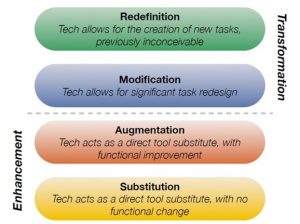The video cases I watched (case 5 and 6) gave an interesting perspective of the use of technology in elementary and middle school classrooms.
Case 5
Some initial thoughts around this video. The class is LOUD! How fortunate that their neighbours are so understanding! The teacher in case 5 said that they use technology almost everyday though I wonder how the technology is shared throughout other classrooms?
I appreciate the teacher’s (Teacher “S”) thoughts regarding technology leveling the field, especially with students from a variety of backgrounds and English language abilities. She recognizes technology as a tool that allows students to overcome some challenges, as well as allowing them to reach out to their families – often on other sides of the world.
Students appeared actively engaged (and noisy) and were all smiles that they got to use technology everyday. The young girls are able to articulate some of the scientific concepts of hurricanes, and were able to describe challenges they faced using technology in their classroom (the amount of information available is overwhelming, though they are learning from their teacher how to search). These are important life skills that technology allows; information is rapidly changing and access to the Web allows for more current information than, say, researching from a book.
I was a bit confused about the Sound Scape project they were working on and subsequent illustrations of the girl in the hurricane. Was this an artistic representation of a hurricane? How is the addition of technology adding to the experiences? I am always concerned that educators are purposeful of the “why behind the technology.
If technology is being used everyday, are students written output needs in English being addressed? Are students being challenged to think critically about space science?
Finally, the retiring teacher feels the way many teachers (even new teachers) feel; there has not been enough professional development opportunities to learn HOW to use technology, let alone the time to devise ways to incorporate it into our classrooms effectively. Using a model, such as SAMR, SECTIONS or the Seven Principles, has definitely given me more direction as to the how/why, but the T (time) still poses significant challenges for many.
Case 6
This teacher uses a variety of technology in his classroom and for a variety of purposes. I think his use of technology to communicate with parents/guardians is very important as it facilitates the home/school connection. I appreciate that he not only sends “marks” and “homework” (that’s another big topics….) but also interesting links, and reminders.
His stations-based approach to this lesson is also interesting. This is a great way to utilize technology when large of amounts of technology is not available. Listening to podcasts, text-books (or other physical books), PowerPoint, scanners, and hands-on dissections address a variety of student learning styles and gives them different experiences. His acknowledgement of the creativity needed to acquire funding for these supplies, ”know who to ask” is important. PAC, admin, district, grants, etc. are available – you just have to know where to look. I do wonder how often he brings in all of these technologies. What does a typical lesson look like without the video cameras there?
Tapping into the technology interests of students does allow for an opening into the content. Many students are going to be paying attention when the material is presented in an engaging way other than a text or video. Students have the material at their fingertips that address their conceptual challenges.
The effort that these teachers are putting into utilizing technology is their classroom is apparent. We can also see that they feel that the amount of time (whether as a beginner or to stay on “the cutting edge”) is a challenge. Pro-D Days offer some solutions. The teacher in Video 6 mentioned talking with colleagues who are also using tech in their classrooms. I think that this is an excellent way to facilitate the use of technology as well as growth. Using the time teachers are given, such as collaboration afternoons, to discuss and learn about the technology available may be a realistic way to address these needs.

Hi Natalie,
I had very similar reactions to Case 5 when I was viewing. The noise was an issue for me, and I wondered how the students actually felt in an
environment like this. I would not be able to learn to my full potential in a space like this. I always think about my students and how they hate when our classroom gets too loud. I also wonder if this classroom flows out into the hallway. I find that when technology is involved in my classroom, we usually overflow into the hallway.
I was also confused watching the project the girls presented on the hurricane. I would have liked to see their final project and their “I can” statements attached to it. What exactly did they learn and how did technology support this inquiry.
Natalie
I like the fact that you brought up that there are not enough professional development opportunities. On one hand, administrators put teachers into situations that they are not ready for and do support them. For example, an administrator telling a teacher they will be teaching an online class when they do not have the skills or desire to. On the other hand, they are so many free ProD opportunities. For example, I am sitting in on three tomorrow (Wednesday, May 31):
– 9am Steve Dotto and Sid: Empowering Modern Course Creators
– 11am Michigan Virtual Learning Research Institute – Examining Student Learning Pathways in an Online Math Course
– 12pm AECT – design and develop immersive learning
I wonder if you could elaborate on “Tapping into the technology interests of students…” What are different ways to “tape” into students interests?
A good next step might be to tie in some of the items you discussed to academic or personal research.
Christopher